An Improved Performance Radar Sensor for K-Band Automotive Radars
Abstract
:1. Introduction
2. MIMO Concept of Radar
3. Antenna Design
3.1. Design of SRR Element
3.2. Grid Antenna Array Results
3.3. Bandwidth and Gain Enhancement Using a Superstrate Dielectric Layer
4. Antenna Performance Evaluation
5. Design of MIMO Radar
5.1. MIMO Antenna Configuration
5.2. Radar Image Reconstruction
6. Conclusions
Author Contributions
Funding
Institutional Review Board Statement
Informed Consent Statement
Data Availability Statement
Conflicts of Interest
References
- Moheb, H.; Shafai, L.; Barakat, M. Design of 24 GHz microstrip travelling wave antenna for radar application. In Proceedings of the IEEE Antennas and Propagation Society International Symposium, Newport Beach, CA, USA, 18–23 June 1995; pp. 350–353. [Google Scholar] [CrossRef]
- Michael, H.; Thurn, K.; Moll, J.; Hossain, M.; Shrestha, A.; Al-Sawaf, T.; Stoppel, D.; Weimann, N.G.; Rämer, A.; Heinrich, W.; et al. A modular MIMO millimeter-wave imaging radar system for space applications and its components. J. Infrared Millim. Terahertz Waves 2021, 42, 275–324. [Google Scholar] [CrossRef]
- Sakakibara, K.; Sugawa, S.; Kikuma, N.; Hirayama, H. Millimeter-wave microstrip array antenna with matching-circuit-integratedradiating-elements for travelling-wave excitation. In Proceedings of the Fourth European Conference on Antennas and Propagation, Barcelona, Spain, 12–16 April 2010; pp. 1–5. [Google Scholar]
- Yu, C.-A.; Li, E.S.; Jin, H.; Cao, Y.; Su, G.-R.; Che, W.; Chin, K.-S. 24 GHz horizontally polarized automotive antenna arrays with wide fan beam and high gain. IEEE Trans. Antennas Propag. 2018, 67, 892–904. [Google Scholar] [CrossRef]
- Abd El-Hameed, A.S.; Sato, M. Antenna array for Ku-band MIMO GB-SAR. IEEE Access 2021, 9, 29565–29572. [Google Scholar] [CrossRef]
- El-Hameed, A.S.A.; Wahab, M.G.; Elshafey, N.A.; Elpeltagy, M.S. Quad-port UWB MIMO antenna based on LPF with vast rejection band. AEU-Int. J. Electron. Commun. 2021, 134, 153712. [Google Scholar] [CrossRef]
- Kraus, J. A backward angle-fire array antenna. IEEE Trans. Antennas Propag. 1964, 12, 48–50. [Google Scholar] [CrossRef]
- Conti, R.; Toth, J.; Dowling, T.; Weiss, J. The wire grid microstrip antenna. IEEE Trans. Antennas Propag. 1981, 29, 157–166. [Google Scholar] [CrossRef]
- Zhang, Y.; Sun, M. An overview of recent antenna array designs for highly-integrated 60-GHz radios. In Proceedings of the 2009 3rd European Conference on Antennas and Propagation, Berlin, Germany, 23–27 March 2009; pp. 3783–3786. [Google Scholar]
- Chen, X.; Wang, G.; Huang, K. A novel wideband and compact microstrip grid array antenna. IEEE Trans. Antennas Propag. 2009, 58, 596–599. [Google Scholar] [CrossRef]
- Zhang, Y.; Sun, M.; Liu, D.; Lu, Y. Dual grid array antennas in a thin-profile package for flip-chip interconnection to highly integrated 60-GHz radios. IEEE Trans. Antennas Propag. 2011, 59, 1191–1199. [Google Scholar] [CrossRef]
- Sun, M.; Zhang, Y.P.; Liu, D.; Chua, K.M.; Wai, L.L. A ball grid array package with a microstrip grid array antenna for a single-chip 60-GHz receiver. IEEE Trans. Antennas Propag. 2011, 59, 2134–2140. [Google Scholar] [CrossRef]
- Nakano, H.; Kawano, T.; Kozono, Y.; Yamauchi, J. A fast MoM calculation technique using sinusoidal basis and testing functions for a wire on a dielectric substrate and its application to meander loop and grid array antennas. IEEE Trans. Antennas Propag. 2005, 53, 3300–3307. [Google Scholar] [CrossRef]
- Al-Alem, Y.; Kishk, A.A. Efficient millimeter-wave antenna based on the exploitation of microstrip line discontinuity radiation. IEEE Trans. Antennas Propag. 2018, 66, 2844–2852. [Google Scholar]
- Zhang, J.; Mao, J. A Miniaturized Ka-Band High-Gain Planar Grid Antenna. In Proceedings of the 2020 9th Asia-Pacific Conference on Antennas and Propagation (APCAP), Xiamen, China, 4–7 August 2020; pp. 1–2. [Google Scholar] [CrossRef]
- Feng, P.; Chen, X.; Ren, X.; Liu, C.-J.; Huang, K.-M. A novel microstrip grid array antenna with both high-gain and wideband properties. Prog. Electromagn. Res. C 2013, 34, 215–226. [Google Scholar] [CrossRef] [Green Version]
- Gulam Nabi Alsath, M.; Kanagasabai, M. Ultra-wideband grid array antenna for automotive radar sensors. IET Microw. Antennas Propag. 2016, 10, 1613–1617. [Google Scholar] [CrossRef]
- Alsath, M.G.N.; Lawrance, L.; Kanagasabai, M. Bandwidth-enhanced grid array antenna for UWB automotive radar sensors. IEEE Trans. Antennas Propag. 2015, 63, 5215–5219. [Google Scholar] [CrossRef]
- Haraz, O.M.; Elboushi, A.; Alshebeili, S.A.; Sebak, A.-R. Dense dielectric patch array antenna with improved radiation characteristics using EBG ground structure and dielectric superstrate for future 5G cellular networks. IEEE Access 2014, 2, 909–913. [Google Scholar] [CrossRef]
- Sultan, K.; Abdullah, H.; Abdallah, E.; El-Hennawy, H. MOM/GA-based virtual array for radar systems. Sensors 2020, 20, 713. [Google Scholar] [CrossRef] [PubMed] [Green Version]
- Chen, X.; Zeng, Y.; Yang, Q.; Deng, B.; Wang, H. An Active Millimeter-Wave Imager Based on MIMO-SAR Scheme. J. Infrared Millim. Terahertz Waves 2021, 42, 1027–1039. [Google Scholar] [CrossRef]
- Dash, J.C.; Sarkar, D. Antenna Array Ambiguity Function Based Study of Integration Effect on a 2D Automotive MIMO RADAR Antenna Placed Behind a Painted Bumper. In Proceedings of the 2022 URSI Regional Conference on Radio Science (USRI-RCRS), Indore, India, 1–4 December 2022. [Google Scholar] [CrossRef]
- Abdullah, H.; Mabrouk, M.; Abd-Elnaby Kabeel, A.; Hussein, A. High-Resolution and Large-Detection-Range Virtual Antenna Array for Automotive Radar Applications. Sensors 2021, 21, 1702. [Google Scholar] [CrossRef]
- Liang, C.; Wang, Y.; Yang, Z.; Hu, X.; Pei, Q.; Gu, W.; Zhang, L. Cooperative Automotive Radars with Multi-Aperture Multiplexing MIMO Sparse Array Design. Electronics 2022, 11, 1198. [Google Scholar] [CrossRef]
- Abd El-Hameed, A.S.; Sato, M. Evaluation of 79 Ghz Mimo Radar under Sandy Conditions in Egypt. In Proceedings of the IGARSS 2022-2022 IEEE International Geoscience and Remote Sensing Symposium, Kuala Lumpur, Malaysia, 17–22 July 2022; pp. 7483–7486. [Google Scholar] [CrossRef]
- Chen, X.; Yang, Q.; Deng, B.; Zeng, Y.; Wang, H. A FFT-Based Millimeter-Wave Imaging Algorithm with Range Compensation for Near-Field MIMO-SAR. J. Infrared Millim. Terahertz Waves 2021, 42, 391–408. [Google Scholar] [CrossRef]
- Zhang, B.; Xu, G.; Zhou, R.; Zhang, H.; Hong, W. Multi-channel back-projection algorithm for mmwave automotive MIMO SAR imaging with Doppler-division multiplexing. IEEE J. Sel. Top. Signal Process. 2022, 17, 445–457. [Google Scholar] [CrossRef]
- Merlo, J.M.; Nanzer, J.A. A C-Band Fully Polarimetric Automotive Synthetic Aperture Radar. IEEE Trans. Veh. Technol. 2021, 71, 2587–2600. [Google Scholar] [CrossRef]
- Al-Tarifi, M.A.; Anagnostou, D.E.; Amert, A.K.; Whites, K.W. Bandwidth enhancement of the resonant cavity antenna by using two dielectric superstrates. IEEE Trans. Antennas Propag. 2013, 61, 1898–1908. [Google Scholar] [CrossRef]
- Cho, H.; Lee, J.H.; Yu, J.W.; Ahn, B. Series-Fed Coupled Split-Ring Resonator Array Antenna With Wide Fan-Beam and Low Sidelobe Level for Millimeter-Wave Automotive Radar. IEEE Trans. Veh. Technol. 2023, 72, 4805–4814. [Google Scholar] [CrossRef]
- Eid, R.; Elboushi, A.; Hindy, M. Wideband monopole antenna with multiple stub resonators for 5G applications. In Proceedings of the 2021 38th National Radio Science Conference (NRSC), Mansoura, Egypt, 27–29 July 2021; pp. 80–87. [Google Scholar]
- El-Nady, S.; Elsharkawy, R.R.; Afifi, A.I.; Abd El-Hameed, A.S. Performance improvement of substrate integrated cavity fed dipole array antenna using ENZ metamaterial for 5G applications. Sensors 2021, 22, 125. [Google Scholar] [CrossRef]
- Sriram, A.; Palaniswamy, S.K.; Manoharan, S. High gain wide band grid array antenna for short range radar and vehicle-to-satellite communications. AEU-Int. J. Electron. Commun. 2022, 147, 154157. [Google Scholar] [CrossRef]



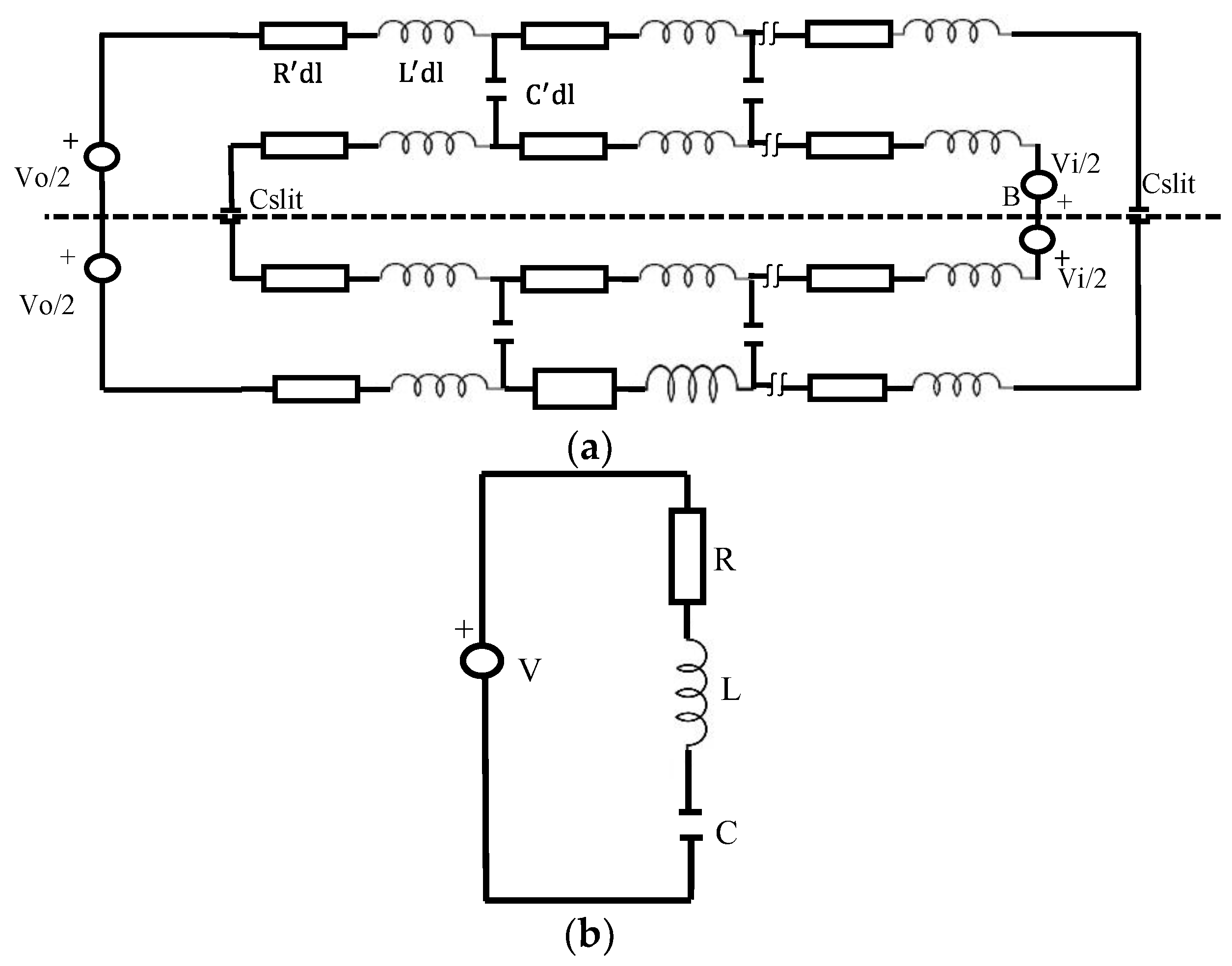


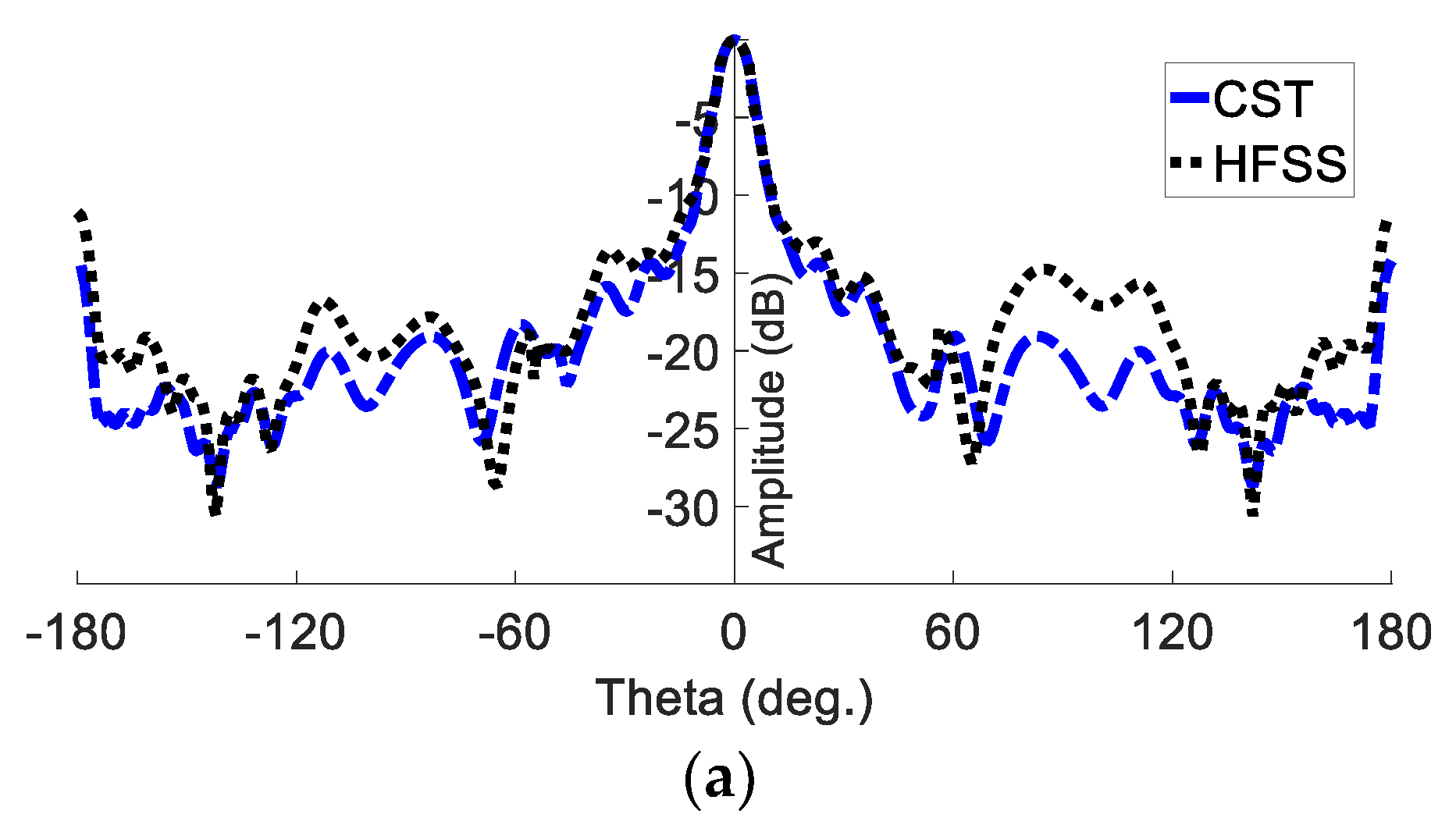

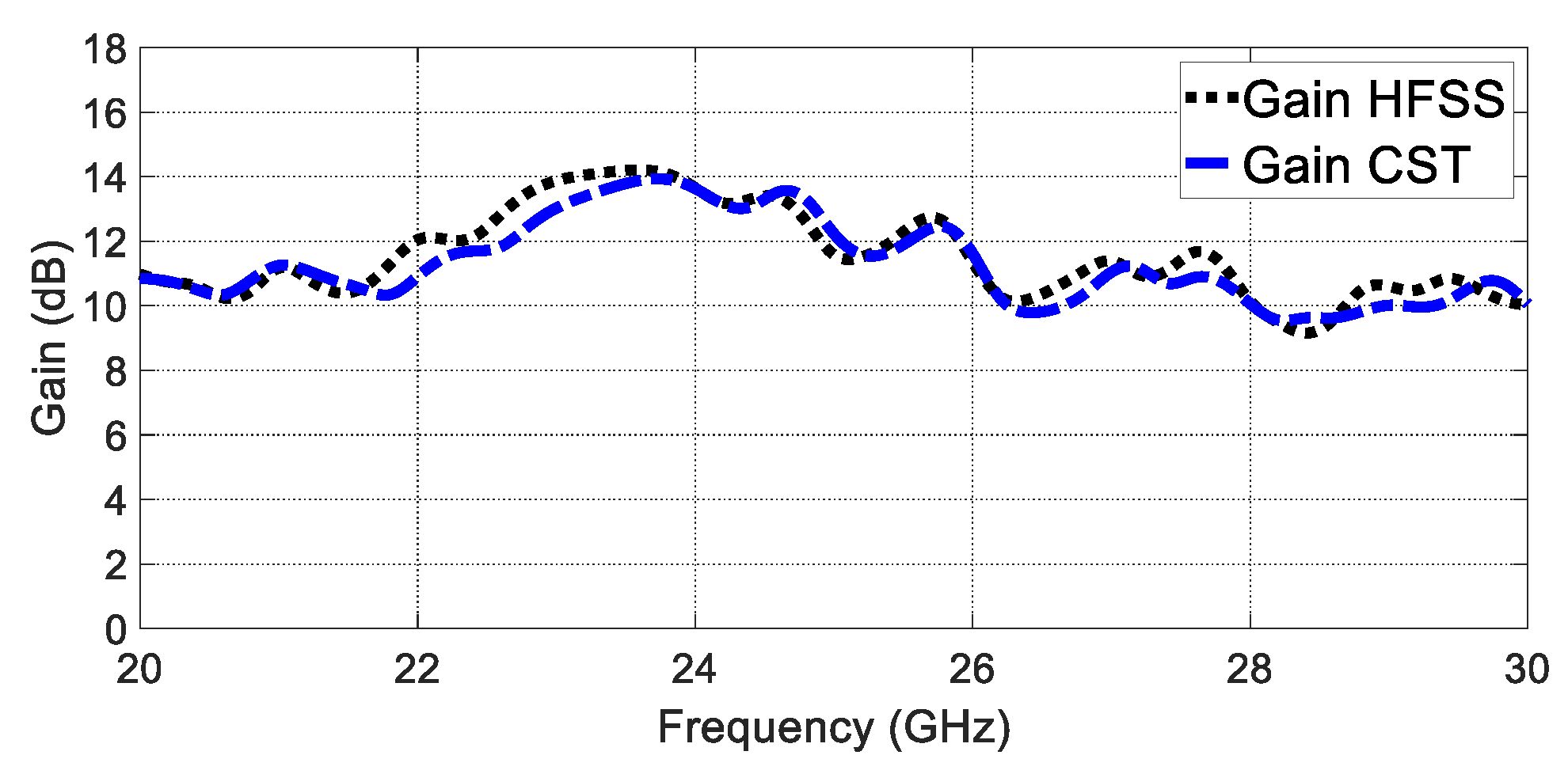
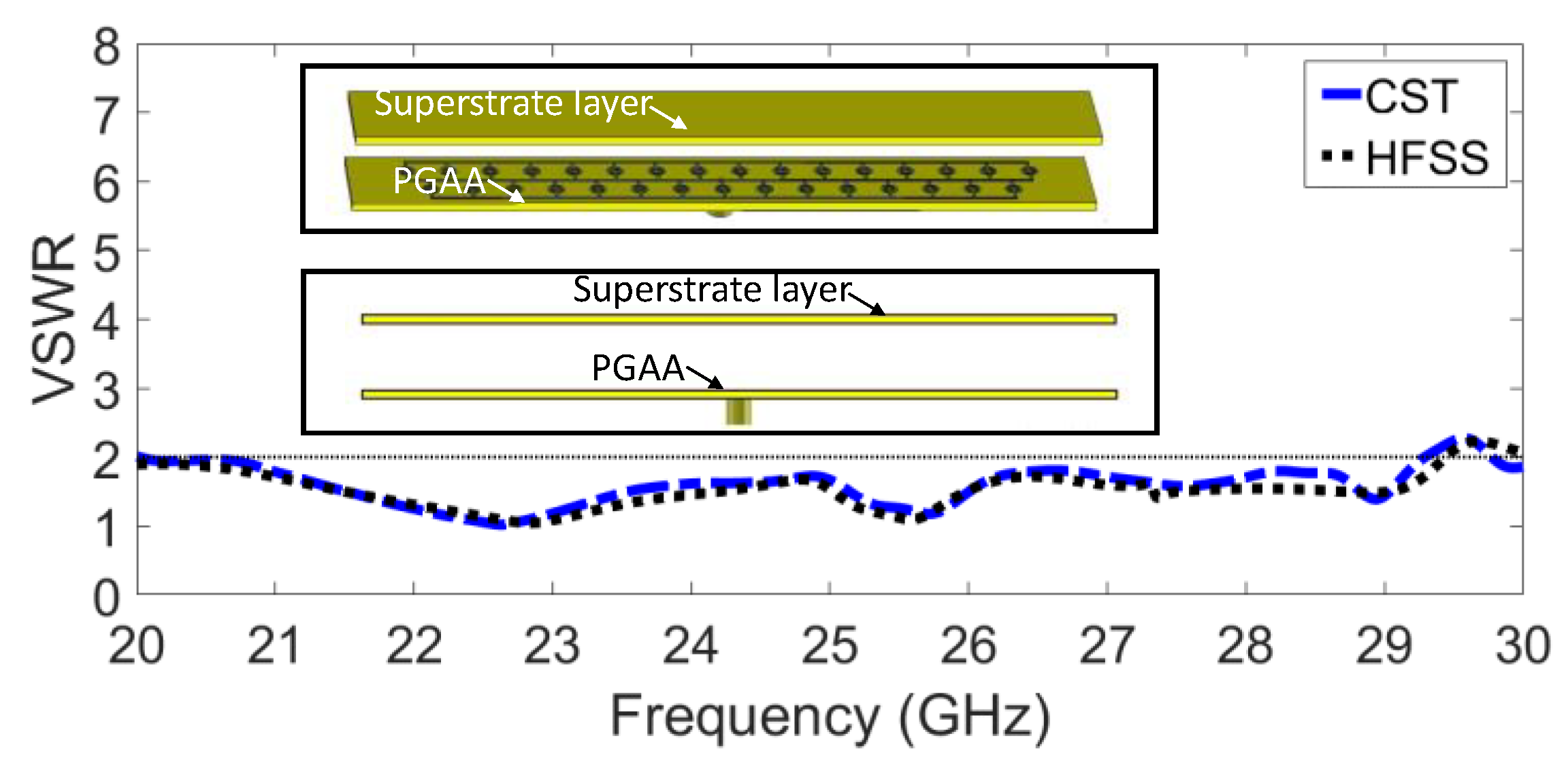
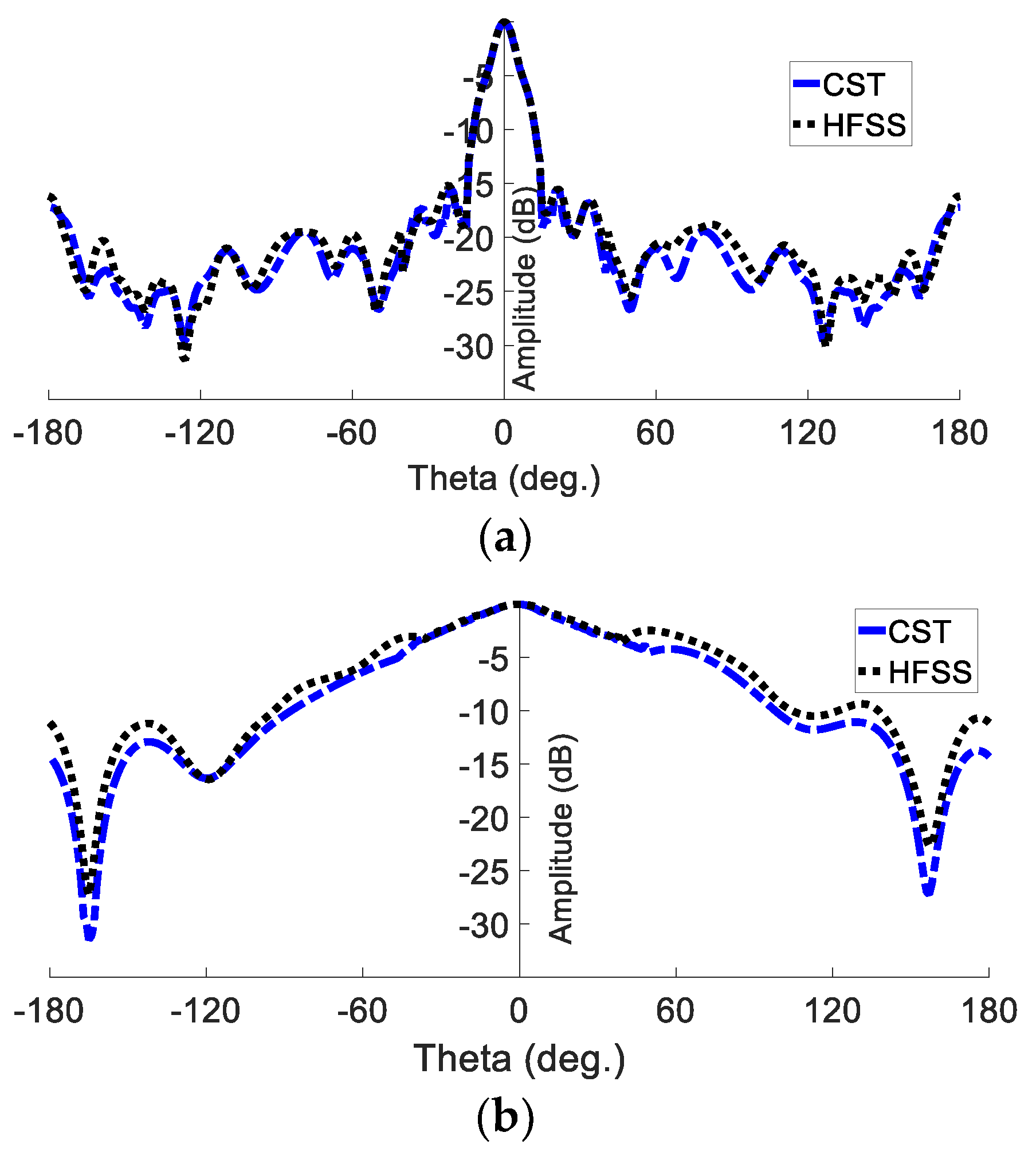
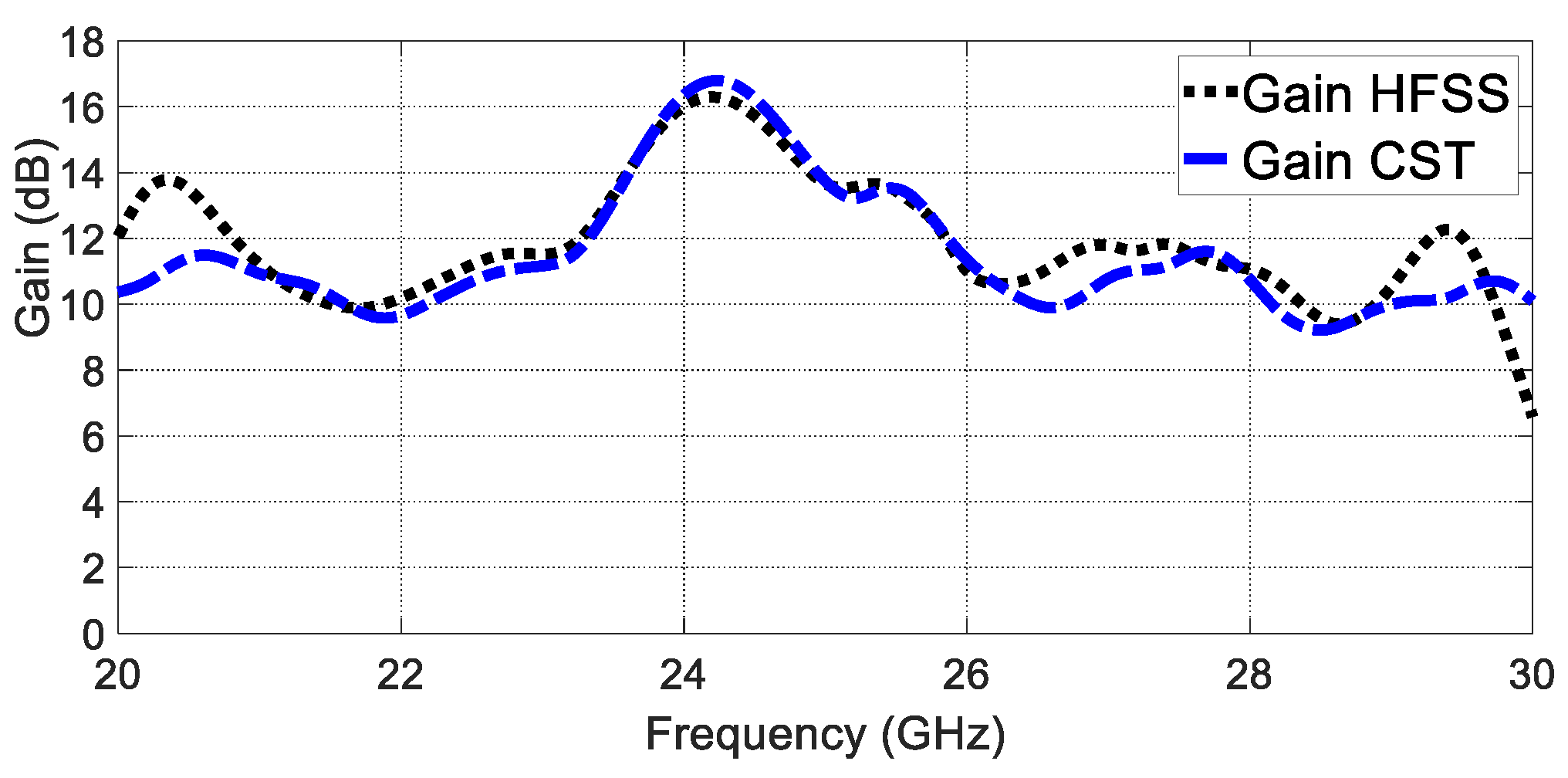
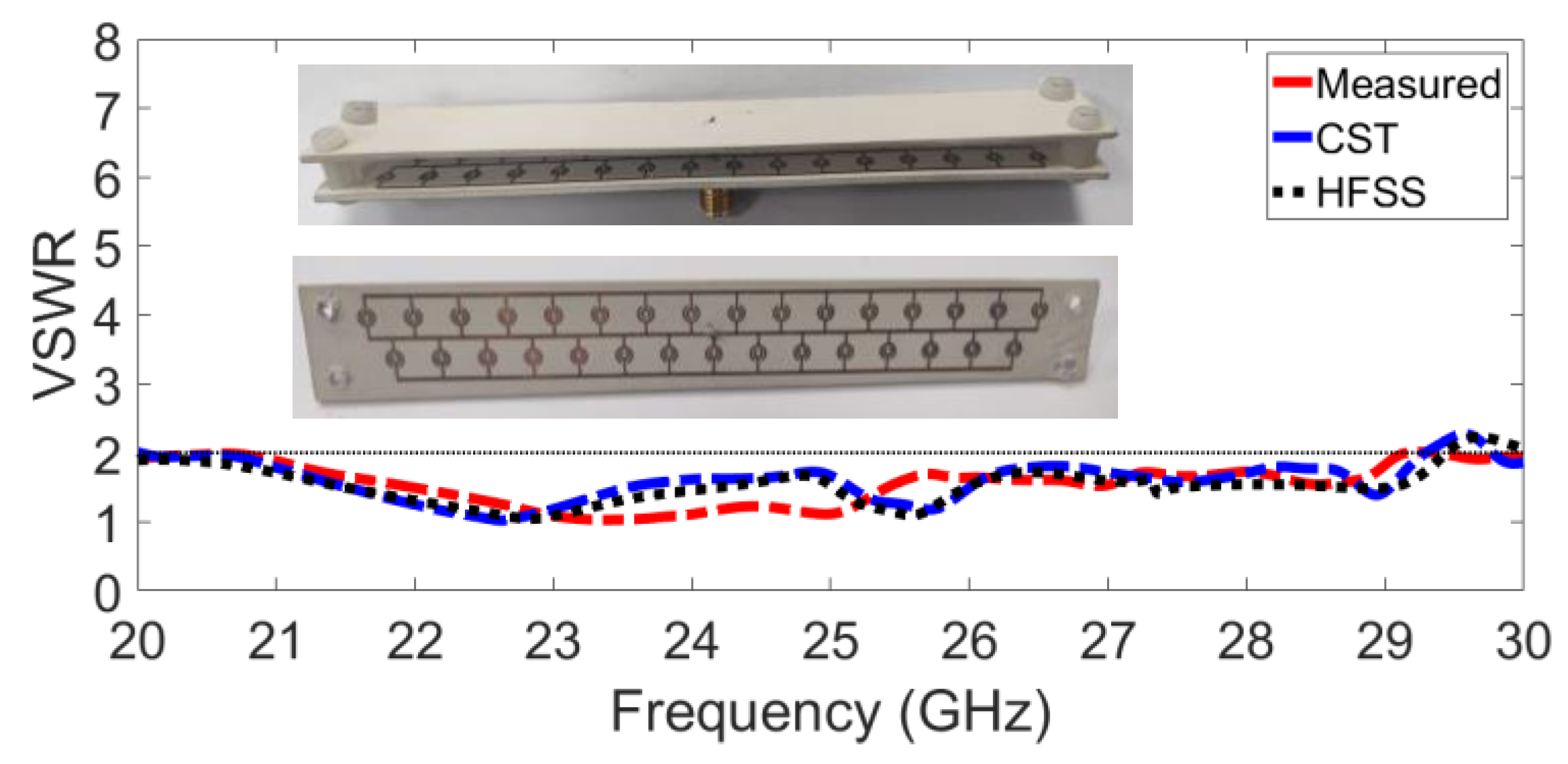

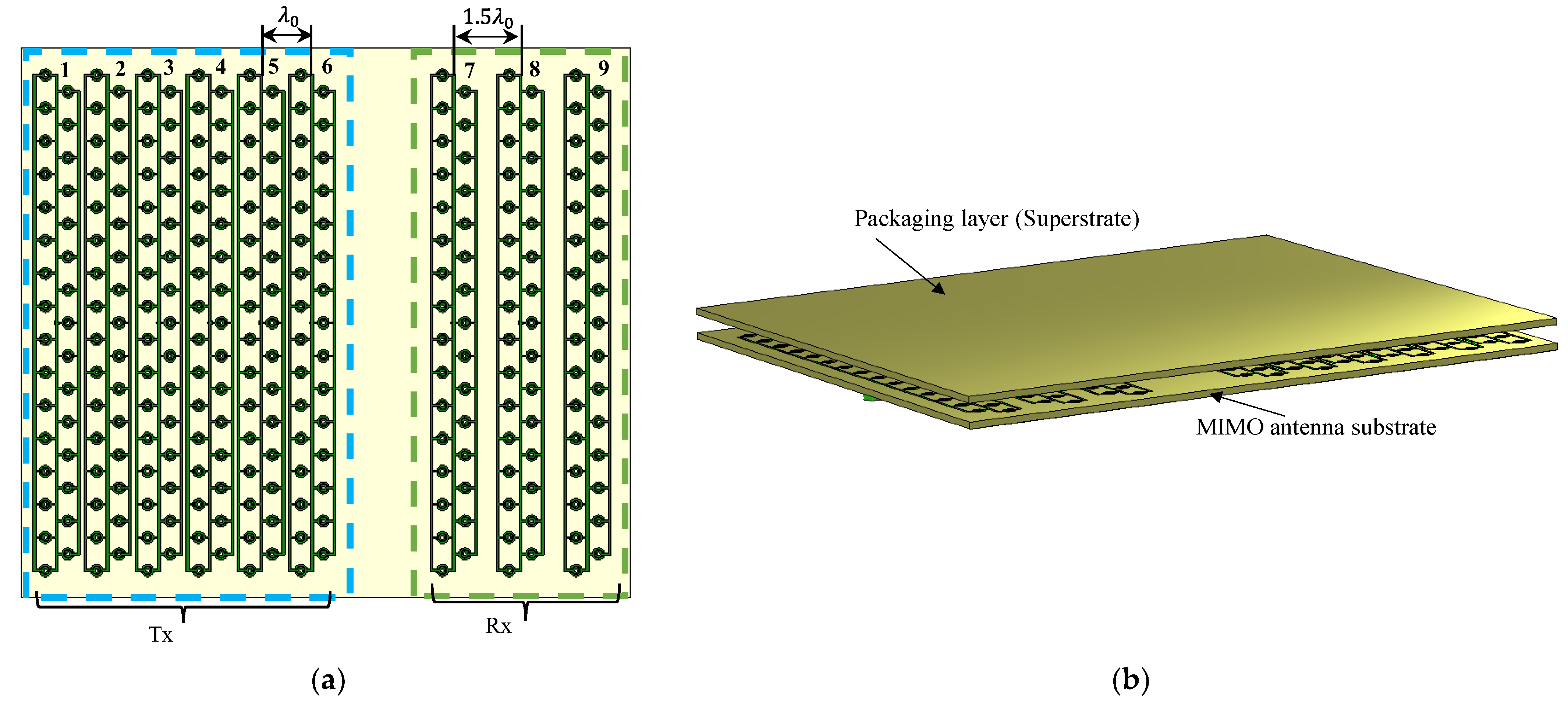
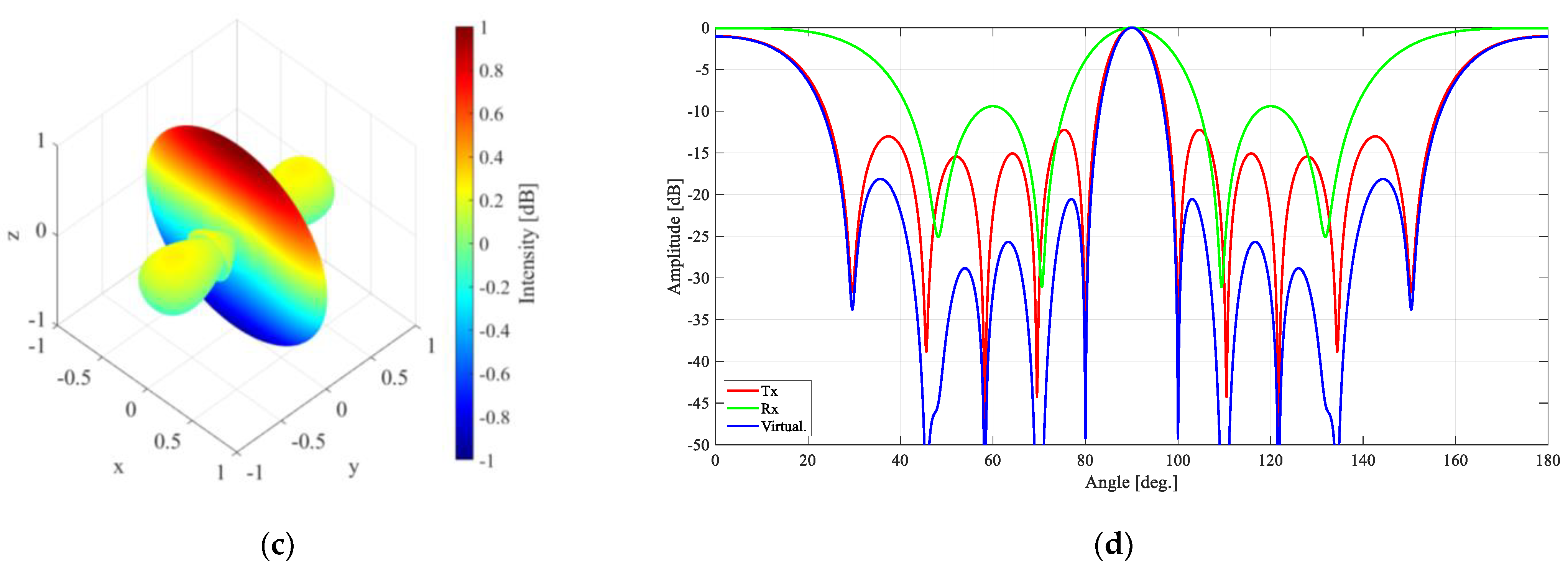




| Ls | Ws | L | W | t | ro | r |
|---|---|---|---|---|---|---|
| 140 | 18 | 4.6 | 0.7 | 0.5 | 1.6 | 0.9 |
| Ref. | Frequency | Polarisation | Antenna Type | Size | Impedance B.W | Peak Gain (dBi) |
|---|---|---|---|---|---|---|
| [4] | 24 GHz | Horizontal polarisation | mushroom-like Array | 71.9 mm × 37 mm | 16.9% | 11.1 |
| [17] | 24 GHz | Linear | Grid Array | 164 mm × 30 mm | 25% | 12.11 |
| [33] | 24 GHz | Linear | Grid Array | 146 mm × 18 mm | 20.88% | 14.2 |
| [18] | 24 GHz | Linear | Grid array | 146 mm × 18 mm | 25% | 11.59 |
| Our work | 24 GHz | Linear | Grid array | 140 mm × 18 mm | 37.7% | 16.5 |
Disclaimer/Publisher’s Note: The statements, opinions and data contained in all publications are solely those of the individual author(s) and contributor(s) and not of MDPI and/or the editor(s). MDPI and/or the editor(s) disclaim responsibility for any injury to people or property resulting from any ideas, methods, instructions or products referred to in the content. |
© 2023 by the authors. Licensee MDPI, Basel, Switzerland. This article is an open access article distributed under the terms and conditions of the Creative Commons Attribution (CC BY) license (https://creativecommons.org/licenses/by/4.0/).
Share and Cite
Abd El-Hameed, A.S.; Ouf, E.G.; Elboushi, A.; Seliem, A.G.; Izumi, Y. An Improved Performance Radar Sensor for K-Band Automotive Radars. Sensors 2023, 23, 7070. https://doi.org/10.3390/s23167070
Abd El-Hameed AS, Ouf EG, Elboushi A, Seliem AG, Izumi Y. An Improved Performance Radar Sensor for K-Band Automotive Radars. Sensors. 2023; 23(16):7070. https://doi.org/10.3390/s23167070
Chicago/Turabian StyleAbd El-Hameed, Anwer S., Eman G. Ouf, Ayman Elboushi, Asmaa G. Seliem, and Yuta Izumi. 2023. "An Improved Performance Radar Sensor for K-Band Automotive Radars" Sensors 23, no. 16: 7070. https://doi.org/10.3390/s23167070






